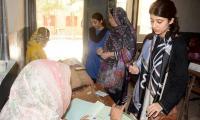With time, darkness tends to fade. We forget about terrible events in our lives, our countries, around the globe – at least to some degree. But as was said for the Holocaust, the horrors of that time can perhaps be forgiven but should never be forgotten.
The same is true for the era of General Muhmmad Ziaul Haq in our country, from 1977 to 1988. There appears to be a new trend over social media to paint Zia and his actions in far lighter shades than can be accepted. However, history should not be altered. Even today, the impact of the laws introduced under that regime haunt us, including the Hudood Ordinance, the Qisas and Diyat law and others which affect people everywhere in the country.
The times may have seen a degree of economic prosperity brought in chiefly by the money pouring in to support the Afghan war against the Soviets. But beyond that, and beyond the few who prospered from that wealth, women who appeared on television to read the news were forced to don dupattas over their heads, bringing about a distinct change from the past. In other ways too, society was altered. Dance, an integral part of life in the Subcontinent and widely acceptable till that age, was declared immodest, un-Islamic and wiped off TV and off public stages. Dancers of the calibre of kathak maestro Naheed Siddiqui were forced overseas.
The loss remains. Even today, dance, notably for women, is regarded by many as immoral and in some circles completely unacceptable. Schools that offer dance classes to girls frequently face complaints from parents about how their children are being corrupted. The beauty of dance, the aesthetics of a high level performance and the part it formed in our culture have been forgotten.
The vloggers who appear on social media channels arguing that pop music prospered under Zia have perhaps forgotten that the lyrics of singers such as Pakistan’s first pop idol Alamgir, a Bengali in origin, were censored before being broadcast on PTV or Radio Pakistan. The word ‘nasha’, or intoxication, was wiped out. Other singers faced similar tough scrutiny, with sister and brother duo Nazia and Zoheb Hassan having to seek special permission to appear together on television and through this period people forgot that ‘raag’ is not alien or from a different culture – it is very much a part of our own heritage. So is instrumental music, whether played on the sitar, the sarangi or on the tabla. Replacing this heritage with Arab culture has simply created a more confused and more conflicted society which has lost its identity and never quite gained it again after the Zia era.
We also need to look at things in a broader context. Yes, it perhaps draws attention to paint a glorified picture of Zia. But can we really do so when we remember the bodies hung on Ferozepur Road in Lahore for hours to ‘teach people a lesson’? The floggings which took place and the scars from such torture which still remain on the bodies of journalists, activists and others who continue to work today? Can we forget the change in curriculums and the removal of poets of the status of Faiz Ahmed Faiz from school textbooks? And should we even try to forget the manner in which this deliberate alteration in social norms has been passed on through the ages and through the generations?
The Single National Curriculum for example bars the use of any figurative display of the human body to show anatomy. Even animals are barely acceptable in terms of illustration. And of course aspects of science fundamental to an understanding of life on Earth, such as evolution, have disappeared completely from the books, leaving school-going children with a censored and limited vision of the world.
Journalists who were active at the time will remember the fear, suspicion and handicaps which existed everywhere with censor boards lifting stories off newspaper pages and a new sense of danger descending on society where plays objecting to the horrors of the time and the manner in which a state of rot had been created performed secretly in private gardens for small audiences, as public cultural performances became more and more limited. This then was the truth. The reality was felt within schools, on streets, in offices where prayer was made compulsory and a new hypocrisy about religion introduced everywhere.
While after Zia there was some change, some opening up of small doors and slit-like windows, the problems continue. An example comes from the concert or ‘rave’ organized in Hunza by a private group. While the group states the people of Hunza were consulted before this event, there has been a fierce attack on it led by a Western origin social media influencer who has spent years in the north of Pakistan. The volume of attacks however raises questions of its own. Some balance has to be found; some thought put into these events. People after all, no matter where they live, cannot be deprived of exposure to a new age and to change.
Why should the young people of Hunza not listen to rock music? There is no compulsion upon them to don the garb of performers or the audiences who collected at the spot. Already, Hunza is changing, with Anita Karim from the area standing out as a mixed martial arts athlete with national and international standing. She dons the garb of all other athletes in her field of expertise. Young skaters have introduced the art of ice dance in areas including Hunza. What is the harm in this?
We must move out of the darkness of the Zia era and seek out light. This is difficult in a time when repression continues and the peculiar notion that keeping people ignorant is somehow to be commended continues. But people everywhere need choice. We have seen young people, including girls from our northern areas, move out into the world and experience the change that comes with travel, education and enlightenment.
Malala Yousafzai, a graduate from Oxford, is one example. So is Maria Toorpakai, who fought all odds to become a squash player with international standing despite the obstacles she faced in her native Waziristan. There are other examples. They bring light, and this light must be expanded until it fills the country and shines everywhere, from the slums of Karachi to the villages and hamlets of more remote parts of the country.
The writer is a freelance columnist and former newspaper editor.
Email: kamilahyat@hotmail.com
Now, court can only act upon applications filed under its jurisdiction
Fact is that let alone Pakistan, Trump hasn’t really spoken much for any South Asian country, not even India
By embracing quantum mechanics, humanity has unlocked technologies once thought unimaginable
Regular reporting could ensure accountability and adaptive management
Report assesses readiness of over 190 countries to meet demands of the international job market
In Pakistan, prospect of introducing Starlink has been topic of discussion, particularly due to frequent internet...







